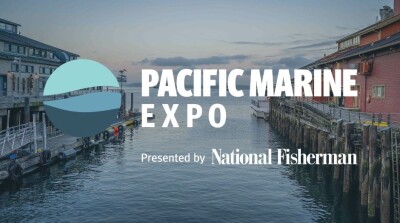Once again the faithful showed up. A land layered with extreme cold, ice and frozen snow didn’t keep them away; if anything it was a very good reason to leave the boat, gear repairs and planning for the coming fishing season to make the annual trek to the Samoset Resort in Rockland, Maine, for the Maine Fishermen’s Forum, held Feb. 27, 28 and March 1.
Just outside the doors leading into the Forum stood a Mitchell Cove 35 hull and top from Journeys End Marina. Leaning against the transom was a ladder, allowing a would-be buyer to climb aboard and check it out.
Inside the hall on Saturday morning was a meeting of the Maine Lobstermen’s Association. What that group and a future owner of the Mitchell Cove have in common is that they fish out of a traditional monohull. It’s a boat design all fishermen take for granted. No questions asked.
Well, not quite. Inside the Forum halls were two booths whose occupants, if they have their way, would see what is probably the most traditional of all American fishermen — New England lobstermen — hauling traps from multihulled boats.
Penobscot East, a group working to maintain healthy fisheries and fishing communities in Eastern Maine, was there with literature on its Green Lobster Boat.
This is a 38-foot trimaran hull designed by Doug Read at the Maine Maritime Academy. The rationale for the trimaran hull is that the traditional Maine lobster boat burns about 3,000 gallons a year and fuel costs constitute about 30 percent of a fisherman’s operating expenses.

Whereas the trimaran hull will substantially reduce fuel costs, thus saving fishermen money. The initial design has been tank-tested, and a 6-foot model was recently matched up against a 6-foot model of a Holland 38 in the waters off San Diego.
Penobscot East is claiming a 20 percent fuel savings up to 16 knots, though results of the testing weren’t in evidence at the booth and some people wanted to see the results of the testing before it would be believed. Currently Penobscot East is looking for funding to build a full-size prototype.
In a nearby exhibit room was the Pro Cat. This is a catamaran design from a company in Ontario. It’s the second generation of this design. The first generation has been sold in England as a replacement for wood and fiberglass longliners and gillnetters. Forty of them are fishing in the North Sea out of English ports.
There are 27- and 32-foot designs; both have 16-foot 6-inch beams. Each hull has a bulbous bow, which is said to improve fuel efficiency by 40 percent over a design without bulbous bows. The initial design is powered with outboards though inboard engines can be used. Twin 150-hp outboards should give the 27-footer a 20-knot speed and twin 200-hp outboards on the 32 footer should get it up to 20 knots.
The first Pro Cat to be built in North America will be launched this summer on Lake Champlain in New York.
What are the chances of a multihull design being used by a New England — especially a Maine — lobsterman? Well, they won’t be winning any lobster boat races; that’s for sure. But if the promoters of the designs can build them at a comparable price to a monohull and get highliners in ports along the coast to try them and their reports of fuel economy and seaworthiness are favorable, then some multihull boats will be hauling gear in New England waters.







